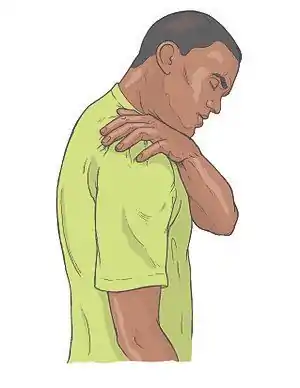Myalgia
Myalgia (also called muscle pain and muscle ache in layman's terms) is the medical term for muscle pain. Myalgia is a symptom of many diseases. The most common cause of acute myalgia is the overuse of a muscle or group of muscles; another likely cause is viral infection, especially when there has been no trauma.
| Myalgia | |
|---|---|
| Other names | Muscle pain, muscle ache |
 | |
| One of the myalgic simptoms | |
| Specialty | Rheumatology |
Long-lasting myalgia can be caused by metabolic myopathy, some nutritional deficiencies, and chronic fatigue syndrome.
Causes
The most common causes of myalgia are overuse, injury, and strain. Myalgia might also be caused by allergies, diseases, medications, or as a response to a vaccination. Dehydration at times results in muscle pain as well, especially for people involved in extensive physical activities such as workout.
Muscle pain is also a common symptom in a variety of diseases, including infectious diseases, such as influenza, muscle abscesses, Lyme disease, malaria, trichinosis or poliomyelitis;[1] autoimmune diseases, such as celiac disease, systemic lupus erythematosus, Sjögren's syndrome or polymyositis;[1][2] gastrointestinal diseases, such as non-celiac gluten sensitivity (which can also occur without digestive symptoms) and inflammatory bowel disease (including Crohn's disease and ulcerative colitis).[3]
The most common causes are:
- Injury or trauma, including sprains, hematoma
- Overuse: using a muscle too much, too often, including protecting a separate injury
- Chronic tension
Muscle pain occurs with:
- Rhabdomyolysis, associated with:
- Viral
- Compression injury leading to crush syndrome
- Drug-related
- Commonly fibrates and statins
- Occasionally ACE inhibitors, cocaine, and some retro-viral drugs
- Severe potassium deficiency
- Fibromyalgia
- Ehlers-Danlos syndrome
- Auto-immune disorders, including:
- Mixed connective tissue disease
- Systemic lupus erythematosus
- Polymyalgia rheumatica
- Polymyositis
- Dermatomyositis
- Multiple sclerosis (this is neurologic pain localised to myotome)
- Infections, including:
- Influenza (the flu)
- Lyme disease
- Babesiosis
- Malaria
- Toxoplasmosis
- Dengue fever
- Hemorrhagic fever
- Muscular abscess
- Compartment syndrome
- Polio
- Rocky Mountain spotted fever
- Trichinosis (roundworm)
- Ebola
- COVID-19
- Other
Overuse
Overuse of a muscle is using it too much, too soon or too often.[7] One example is repetitive strain injury. See also:
- Exercise
- Weight lifting
Autoimmune
- Multiple sclerosis (neurologic pain interpreted as muscular)
- Myositis
- Mixed connective tissue disease
- Lupus erythematosus
- Fibromyalgia syndrome
- Familial Mediterranean fever
- Polyarteritis nodosa
- Devic's disease
- Morphea
- Sarcoidosis
Metabolic defect
- Carnitine palmitoyltransferase II deficiency
- Conn's syndrome
- Adrenal insufficiency
- Hyperthyroidism
- Hypothyroidism
- Diabetes
- Hypogonadism
- Postorgasmic illness syndrome[4][5][6]
Other
- Chronic fatigue syndrome (aka myalgic encephalomyelitis)
- Channelopathy
- Ehlers Danlos Syndrome
- Stickler Syndrome
- Hypokalemia
- Hypotonia
- Exercise intolerance
- Mastocytosis
- Peripheral neuropathy
- Eosinophilia myalgia syndrome
- Barcoo Fever
- Herpes
- Hemochromatosis
- Delayed onset muscle soreness
- HIV/AIDS
- Generalized anxiety disorder
- Tumor-induced osteomalacia
- Hypovitaminosis D
- Infarction[8]
Withdrawal syndrome from certain drugs
Sudden cessation of high-dose corticosteroids, opioids, barbiturates, benzodiazepines, caffeine, or alcohol can induce myalgia.
Treatment
When the cause of myalgia is unknown, it should be treated symptomatically. Common treatments include heat, rest, paracetamol, NSAIDs, massage, cryotherapy[9] and muscle relaxants.[10]
See also
- Arthralgia
- Myopathy
- Myositis
References
- "Dolores musculares: MedlinePlus enciclopedia médica". medlineplus.gov (in Spanish). Retrieved 2022-10-28.
- Vitali, Claudio; Del Papa, Nicoletta (February 2015). "Pain in primary Sjögren's syndrome". Best Practice & Research. Clinical Rheumatology. 29 (1): 63–70. doi:10.1016/j.berh.2015.05.002. ISSN 1532-1770. PMID 26267000.
- Tovoli, Francesco (2015). "Clinical and diagnostic aspects of gluten related disorders". World Journal of Clinical Cases. 3 (3): 275. doi:10.12998/wjcc.v3.i3.275. ISSN 2307-8960.
- Balon R, Segraves RT, eds. (2005). Handbook of Sexual Dysfunction. Taylor & Francis. ISBN 9780824758264.
- Wylie KR, ed. (2015). ABC of Sexual Health. John Wiley & Sons. p. 75. ISBN 9781118665565.
- "Postorgasmic illness syndrome". Genetic and Rare Diseases Information Center (GARD). National Institutes of Health. 2015. Retrieved 30 July 2015.
- MedlinePlus
- Glueck, CharlesJ; Conrad, Brandon (2013). "Severe vitamin D deficiency, myopathy, and rhabdomyolysis". North American Journal of Medical Sciences. 5 (8): 494–495. doi:10.4103/1947-2714.117325. ISSN 1947-2714. PMC 3784929. PMID 24083227.
- "Cryotherapy | How does cryotherapy works". Vacuactivus cryotherapy. 2020-04-06. Retrieved 2022-10-28.
- Shmerling, Robert H (April 25, 2016). "Approach to the patient with myalgia". UpToDate. Retrieved 2018-05-27.